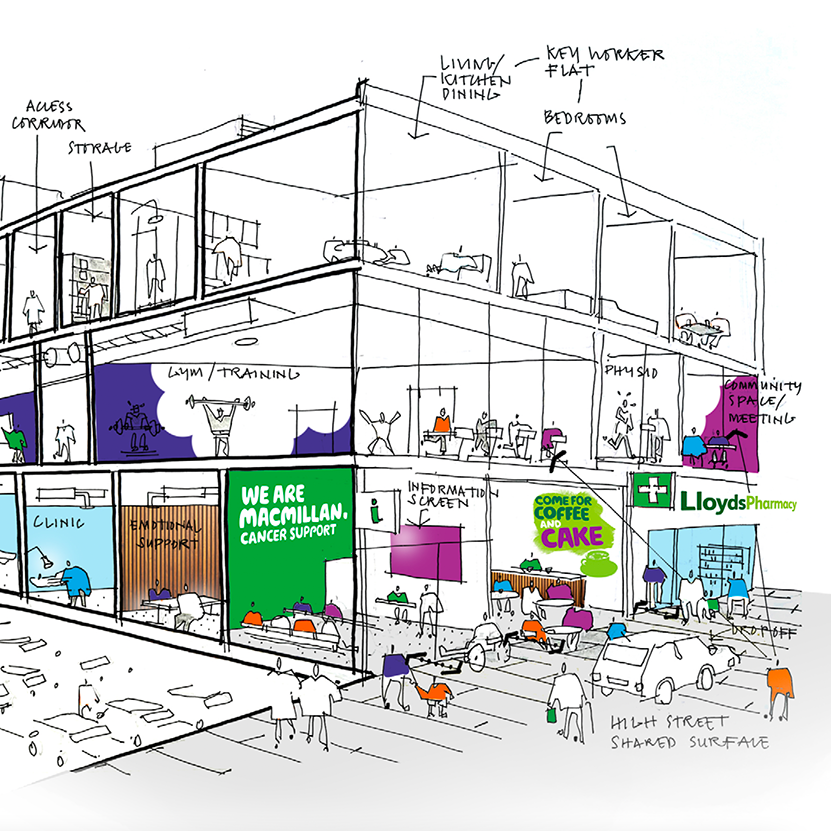Hannah Brewster from ADP makes the case for using empty retail space to take outpatient services out of the hospital and onto the high street.
ADP Architecture’s Shopping for Health concept seeks to repurpose shopping centres to meet the growing need for community-centred outpatient services and other vital healthcare facilities.
The Covid pandemic has transformed our world. But while we’re becoming familiar with the challenges it has presented, we’re perhaps neglecting the teachings that can be taken. We can see how changing patterns of living and working have affected UK high streets and the strain that the pandemic has put on the NHS. But what’s missing from the conversation is how to respond to these circumstances in a way that can benefit society; a way that treats the response holistically, and combines better healthcare provision with new relevance and vitality for our high streets.
In the coming years, we are potentially going to need approximately 1.25 million square metres of space to accommodate a spectrum of health services. One million square metres of this is projected to be required in order to move appropriate outpatient services from hospital settings into more community-based locations, freeing up hospitals for the more acutely unwell. The other 250,000 square metres will be needed to fulfil requirements for additional roles that have been laid out in the NHS’ Primary Care Network manifesto, which aims to better integrate primary care with more community-based services.
We’re talking about a significant amount of space, which is both responding to – and potentially formative of – dramatic shifts in the configuration of healthcare provision. Mobilising such space will be far from easy, especially if we attempt to build it anew. But what if the space required to enact this shift has already been built and currently resides in vacant retail premises up and down the country? In shopping centres, with their 1.6 million square-metres of available space, we can perhaps find the key to unlock these intersecting issues.
Tried and tested
The idea of retrofitting shopping centres into healthcare facilities isn’t as new as it sounds. ADP Architecture, in partnership with Macmillan Cancer Support, has been working alongside iDEA and Carter Jonas, researching the possibilities, and is already working with clients on testbed cases. In Runcorn, ADP is helping Warrington and Halton Teaching Hospitals’ NHS Foundation Trust to relocate their ophthalmology and audiology outpatient services into a vacant retail unit in Runcorn Shopping City.
In Gloucester we’re designing a major new city centre campus for the University of Gloucestershire, combining clinical education with patient-facing NHS services – all within a refurbished department store.
Accessibility is key to the success of this approach. The provision of car parking, public transport, welfare facilities, the ability to service and pick up, and physical location are advantageous. Such desirables go hand-in-hand with the nature of high street locations, and shopping centres also offer convenience and familiarity with retail outlets within the destination.
As part of our study, we have explored the concept of offering spatial hubs to bring flexibility and provide a scalable model to accommodate a variety of clinics and health facilities. These hubs are orientated to guide visitors through a patient-facing street access into a reception and waiting area. This opens onto clinic facilities, including consultation rooms and counselling spaces. As you move further into the footprint, the functional use changes from public to private. At the rear of the facility, staff and support spaces are provided which in turn give access to delivery and servicing areas.
The size of the hub is key – our research has put the minimum viable size of facility at 490 square metres, which broadly equates to a typical small GP Practice. This standard module can be used in multiples to provide larger facilities. Although the concept is based on a single floor, this isn’t a limitation. The approach could be applied across multiple levels of a building and consider how different facilities and services could integrate across a wider area.
Our proposal is about looking for opportunities to provide a wider, holistic offering, and co-locating complementary wellbeing services alongside clinical facilities (allied retailers already comprise five per cent of total shopping centre stock in the form of chemists, opticians, dentists, and suchlike). We believe there is an opportunity for this proportion to increase with footfall driven by ‘Shopping for Health’. There are also the benefits of complementary support and wellbeing services, such as Macmillan, who is actively looking to provide further support through Macmillan Cancer Information and Support Centres in locations that are relevant, easy to reach and in areas of high deprivation. Our live project at Runcorn Shopping City even provides space for Halton Haven Hospice services and a Citizens Advice Bureau alongside the NHS outpatient clinical facilities.
Breaking down boundaries
There is also an ethos of sustainability at the core of retrofit – it is an approach that is greener than new build, and offers the opportunity to address the NHS Net Zero Carbon agenda alongside other key NHS targets. This includes opportunities for digital transformation, standardisation and future flexibility offering financial, maintenance and life cycle advantages.
Shopping for Health is not theoretical – our real-life implementation of this concept demonstrates that it is a practical, deliverable solution. With a little creativity, supply and demand we can cross traditional boundaries of use, bringing appropriate healthcare facilities back into the heart of the communities they serve. This has benefits for everyone: NHS Trusts have new, well-located spaces to provide care; patients can access healthcare in more convenient ways; landlords have reliable long-term tenants for vacant units; adjacent tenants have increased footfall – particularly relevant when they provide products or services aligned with health and wellbeing; and communities and places can be regenerated economically, socially, and culturally, as part of our recovery in a post-Covid world. With so many advantages, an approach like this might just be the future of healthcare.
Source: Architecture Today

